《传播学导论》课程教学资源(阅读材料)The Knowledge-Gap Hypothesis
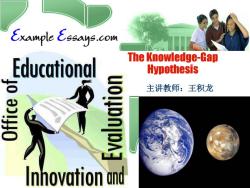
Examplc Essays.com Educational The Knowledge-Gap Hypothesis 主讲教师:王积龙 Inhovation and
The Knowledge-Gap Hypothesis 主讲教师:王积龙
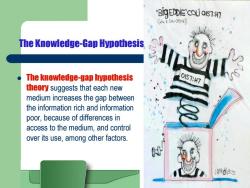
"BIQ EDDE'COLi 0I57:H7 aka E.CoL057:H The Knowledge-Gap Hypothesis The knowledge-gap hypothesis 0157:H7 theory suggests that each new medium increases the gap between the information rich and information poor,because of differences in access to the medium,and control over its use,among other factors. U你的如
The Knowledge-Gap Hypothesis The knowledge-gap hypothesis theory suggests that each new medium increases the gap between the information rich and information poor, because of differences in access to the medium, and control over its use, among other factors
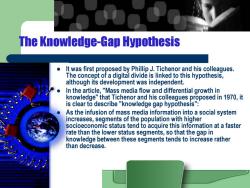
The Knowledge-Gap Hypothesis ● It was first proposed by Phillip J.Tichenor and his colleagues The concept of a digital divide is linked to this hypothesis, although its development was independent. ● In the article,"Mass media flow and differential growth in knowledge"that Tichenor and his colleagues proposed in 1970,it is clear to describe "knowledge gap hypothesis": As the infusion of mass media information into a social system increases,segments of the population with higher socioeconomic status tend to acquire this information at a faster rate than the lower status segments,so that the gap in knowledge between these segments tends to increase rather than decrease
The Knowledge-Gap Hypothesis It was first proposed by Phillip J. Tichenor and his colleagues. The concept of a digital divide is linked to this hypothesis, although its development was independent. In the article, "Mass media flow and differential growth in knowledge" that Tichenor and his colleagues proposed in 1970, it is clear to describe "knowledge gap hypothesis": As the infusion of mass media information into a social system increases, segments of the population with higher socioeconomic status tend to acquire this information at a faster rate than the lower status segments, so that the gap in knowledge between these segments tends to increase rather than decrease
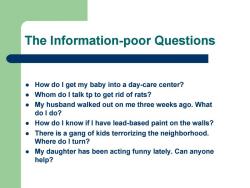
The Information-poor Questions How do I get my baby into a day-care center? Whom do I talk tp to get rid of rats? My husband walked out on me three weeks ago.What do I do? How do I know if I have lead-based paint on the walls? There is a gang of kids terrorizing the neighborhood. Where do I turn? ● My daughter has been acting funny lately.Can anyone help?
The Information-poor Questions How do I get my baby into a day-care center? Whom do I talk tp to get rid of rats? My husband walked out on me three weeks ago. What do I do? How do I know if I have lead-based paint on the walls? There is a gang of kids terrorizing the neighborhood. Where do I turn? My daughter has been acting funny lately. Can anyone help?

The Prototypal Disadvantaged American ● Does not know which formal channels to tap in order to solve his problems,or what specific programs exist to respond to his need. Watches many hours of television daily,seldom reads newspapers or magazines,and never reads books. Does not see his questions as information needs;is not a very active information seeker,even when he does undertake a search
The Prototypal Disadvantaged American Does not know which formal channels to tap in order to solve his problems, or what specific programs exist to respond to his need. Watches many hours of television daily, seldom reads newspapers or magazines, and never reads books. Does not see his questions as information needs; is not a very active information seeker, even when he does undertake a search
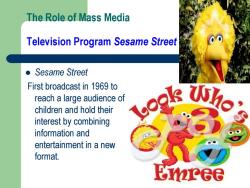
The Role of Mass Media Television Program Sesame Street Sesame Street First broadcast in 1969 to reach a large audience of children and hold their interest by combining information and entertainment in a new format. Emaree
The Role of Mass Media Television Program Sesame Street Sesame Street First broadcast in 1969 to reach a large audience of children and hold their interest by combining information and entertainment in a new format

The Role of Mass Media High Socioeconomic Status Low Socioeconomic Status Time(or Exposure to Information) Figure 12.I The knowledge-gap hypothesis. that the gap in knowledge between these segments tends to increase rather than decrease.(pp.159-160)
The Role of Mass Media
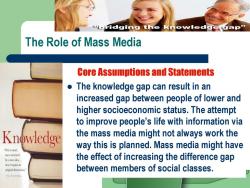
bridging the nowledge gap The Role of Mass Media Core Assumptions and Statements The knowledge gap can result in an increased gap between people of lower and higher socioeconomic status.The attempt to improve people's life with information via Knowledge the mass media might not always work the way this is planned.Mass media might have One's mind. sttched by a new idea. the effect of increasing the difference gap never regains its original dimensions between members of social classes. rmH
Core Assumptions and Statements The knowledge gap can result in an increased gap between people of lower and higher socioeconomic status. The attempt to improve people’s life with information via the mass media might not always work the way this is planned. Mass media might have the effect of increasing the difference gap between members of social classes. The Role of Mass Media
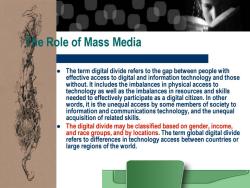
e Role of Mass Media The term digital divide refers to the gap between people with effective access to digital and information technology and those without.It includes the imbalances in physical access to technology as well as the imbalances in resources and skills needed to effectively participate as a digital citizen.In other words,it is the unequal access by some members of society to information and communications technology,and the unequal acquisition of related skills. The digital divide may be classified based on gender,income, and race groups,and by locations.The term global digital divide refers to differences in technology access between countries or large regions of the world
The term digital divide refers to the gap between people with effective access to digital and information technology and those without. It includes the imbalances in physical access to technology as well as the imbalances in resources and skills needed to effectively participate as a digital citizen. In other words, it is the unequal access by some members of society to information and communications technology, and the unequal acquisition of related skills. The digital divide may be classified based on gender, income, and race groups, and by locations. The term global digital divide refers to differences in technology access between countries or large regions of the world. The Role of Mass Media

80 College 70 60 High School 0 Grade School 20 10 1949 1954 1959 1965 Figure 12.2 Respondents in national surveys stating belief that man will reach the moon, by education and year.Source:From P.J.Tichenor,G.A.Donohue,and C.N.Olien,"Mass Media Flow and Differential Growth in Knowledge,"Public Opinion Quarterly 34(1970):166.Copyright 1970 by Columbia University Press.Reprinted by permission of the University of Chicago Press. 2.At a given time,there should be a higher correlation between acquisition of knowledge and education for topics highly publicized in the media than for topics less highly publicized
按次数下载不扣除下载券;
注册用户24小时内重复下载只扣除一次;
顺序:VIP每日次数-->可用次数-->下载券;
- 《传播学导论》课程教学资源(阅读材料)Perception and Language Issues in the Mass Media.pdf
- 《传播学导论》课程教学资源(阅读材料)Measurement of Readability.pdf
- 《传播学导论》课程教学资源(阅读材料)Mass Media Effects and Uses.pdf
- 《传播学导论》课程教学资源(阅读材料)Mass Media and Interpersonal Communication.pdf
- 《传播学导论》课程教学资源(阅读材料)Health Communication.pdf
- 《传播学导论》课程教学资源(阅读材料)From Marshall Mcluhan to postmodernism.pdf
- 《传播学导论》课程教学资源(阅读材料)Effects of Media Communication.pdf
- 《传播学导论》课程教学资源(阅读材料)Communication Model.pdf
- 《传播学导论》课程教学资源(阅读材料)Cognitive Consistency.pdf
- 《传播学导论》课程教学资源(阅读材料)Analysis of Propaganda Decoding & Its Effects.pdf
- 《新闻学概论》课程教学资源(学习笔记)新闻学概论课堂笔记.pdf
- 《新闻采访》课程教学资源(文献资料)异地采访经验谈.doc
- 《新闻采访》课程教学资源(文献资料)现场采访经验.doc
- 《新闻采访》课程教学资源(文献资料)国际足球赛事采访经验谈.doc
- 《新闻采访》课程教学资源(文献资料)采访写作课的新理念与新实践.pdf
- 《新闻采访》课程教学资源(文献资料)简论典型人物的采访技巧.pdf
- 《新闻采访》课程教学资源(文献资料)论电视新闻采访的真实性、简论典型人物的采访技巧.pdf
- 《新闻采访》课程教学资源(文献资料)谈电视新闻采访中的女性特质.pdf
- 《新闻采访》课程教学资源(文献资料)试论新时期我国付费采访的表现形式及其影响.pdf
- 《新闻采访》课程教学资源(文献资料)越看越糊涂的报纸新闻——谈记者的采访要领和利用传媒特许权.pdf
- 《传播学导论》课程教学资源(阅读材料)Theory of Persuasion.pdf
- 《传播学导论》课程教学资源(阅读材料)Uses and Gratification Approach.pdf
- 苏州大学:《电视摄像基础》课程教学资源(课件讲稿)第一章 摄像机(1节)摄像机发展史.pdf
- 苏州大学:《电视摄像基础》课程教学资源(课件讲稿)第一章 摄像机(2节)摄像机的结构(A).pdf
- 苏州大学:《电视摄像基础》课程教学资源(课件讲稿)第一章 摄像机(2节)摄像机的结构(B).pdf
- 苏州大学:《电视摄像基础》课程教学资源(课件讲稿)第一章 摄像机(3节)节摄像机的调整与使用.pdf
- 苏州大学:《电视摄像基础》课程教学资源(课件讲稿)第一章 摄像机(4节)摄像机持机方式.pdf
- 苏州大学:《电视摄像基础》课程教学资源(课件讲稿)第一章 摄像机(5节)摄像机的分类.pdf
- 苏州大学:《电视摄像基础》课程教学资源(课件讲稿)第二章 电视画面.pdf
- 苏州大学:《电视摄像基础》课程教学资源(课件讲稿)第三章 电视画面构图.pdf
- 苏州大学:《电视摄像基础》课程教学资源(课件讲稿)第五章 固定画面.pdf
- 苏州大学:《电视摄像基础》课程教学资源(课件讲稿)第六章 电视场面调度.pdf
- 苏州大学:《电视摄像基础》课程教学资源(课件讲稿)第四章 电视摄像用光.pdf
- 苏州大学:《电视摄像基础》课程教学资源(课件讲稿)HVX200操作要领(10个如何).pdf
- 苏州大学:《电视摄像基础》课程教学资源(课件讲稿)第七章 电视画面的蒙太奇规律.pdf
- 苏州大学:《电视摄像基础》课程教学资源(课件讲稿)第九章 电视艺术片拍摄.pdf
- 苏州大学:《电视摄像基础》课程教学资源(课件讲稿)第八章 电视新闻纪实拍摄.pdf
- 苏州大学:《非线性编辑基础》课程教学资源(课件讲稿)数字影像编辑系统(A)数字视频基本概念.pdf
- 苏州大学:《非线性编辑基础》课程教学资源(课件讲稿)数字影像编辑系统(B)标清和高清的定义.pdf
- 苏州大学:《非线性编辑基础》课程教学资源(课件讲稿)数字影像编辑系统(C)非线性编辑系统.pdf
